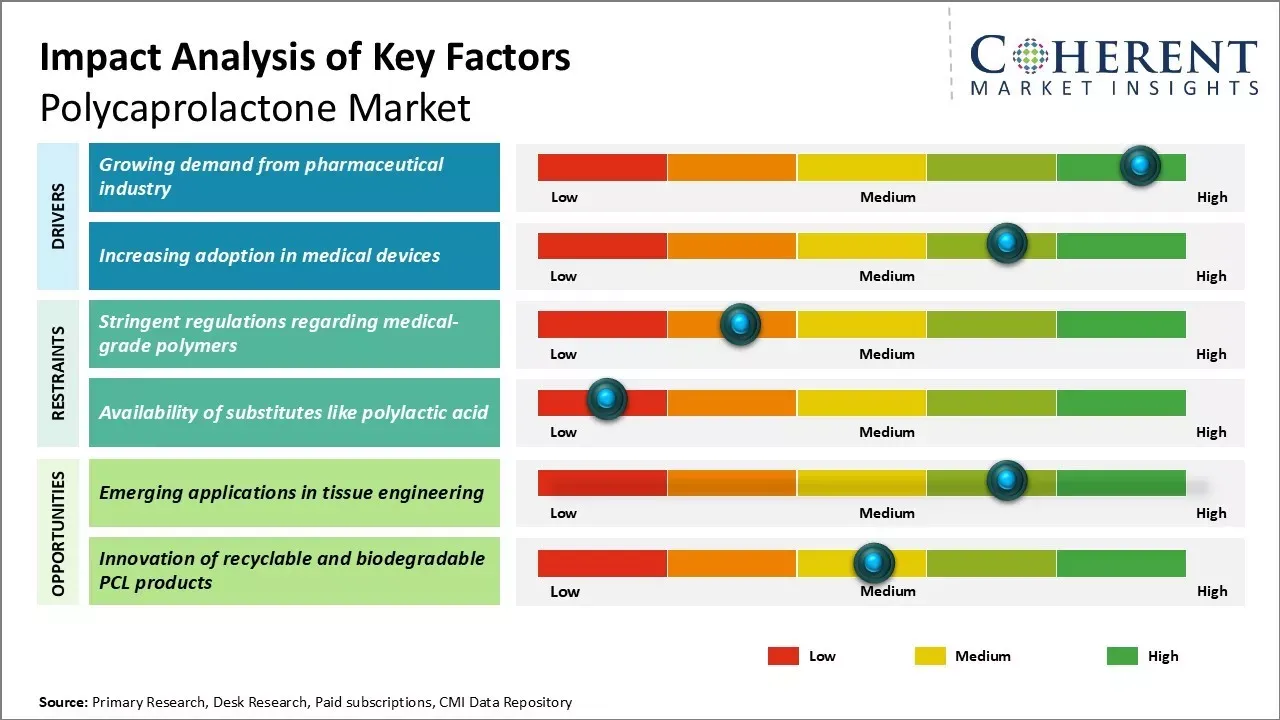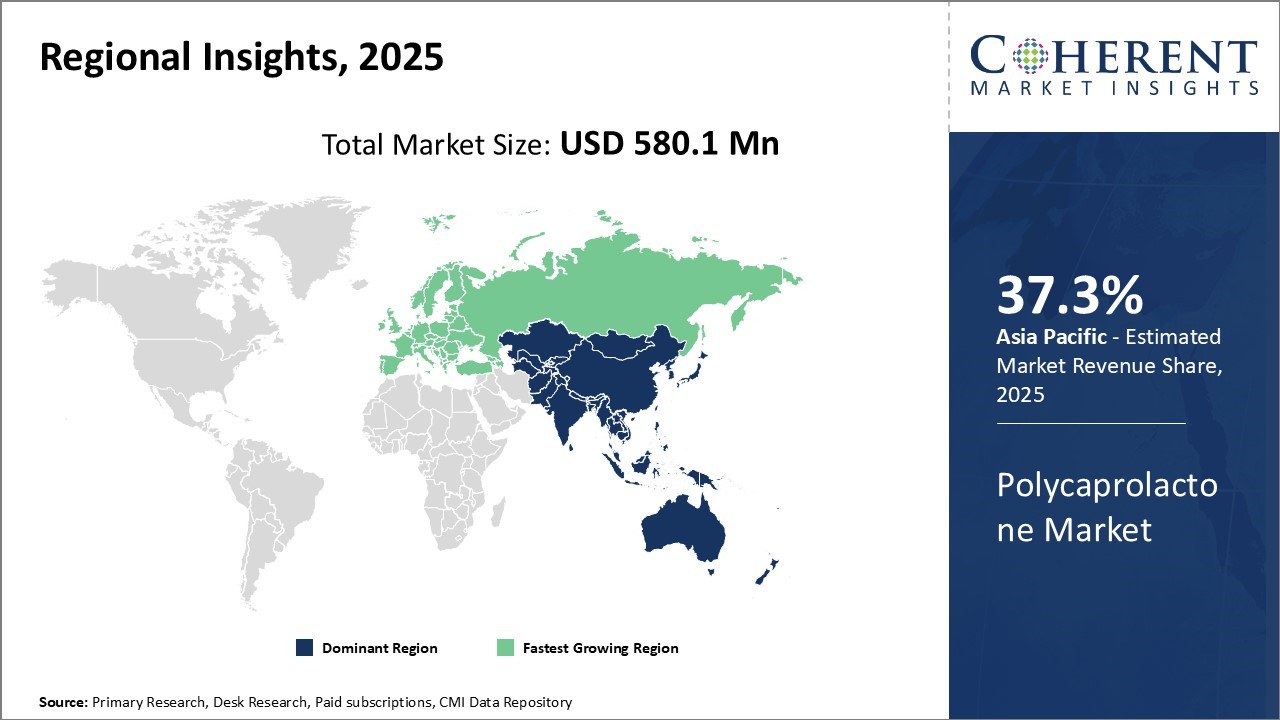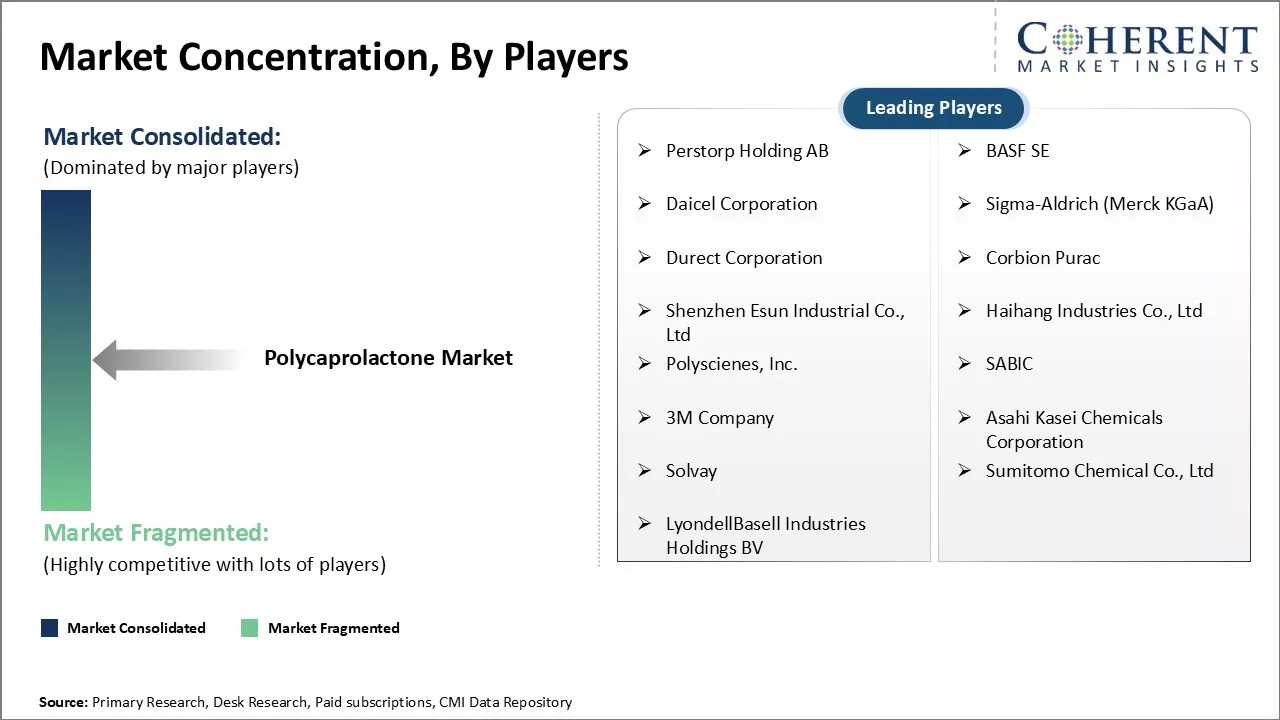Polycaprolactone market is estimated to be valued at USD 580.1 Mn in 2025 and is expected to reach USD 1,088.7 Mn by 2032, exhibiting a compound annual growth rate (CAGR) of 9.4% from 2025 to 2032.

To learn more about this report, Download Free Sample
Based on Form Type, the Pellets/Granules segment is expected to lead the market holding a share of 58.9% in the market in 2025, owing to their convenience and cost efficiency.
Based on Grade, the High Molecular Weight PCL segment is projected to dominate with a share of 54.2% in the market in 2025, supported by the superior strength and stability.
Based on Application, the Drug Delivery Systems segment is estimated to lead the market with a share of 21.7% in the market in 2025 due to the versatility of PCL.
Based on Region, Asia Pacific is estimated to lead the market with a share of 37.3% in 2025 due to the strong presence of leading manufacturers. While, Europe, holding a share of considerable share and is projected to be the fastest growing region in the forecast period.
Rising demand for thermoplastics from healthcare sector for applications such as medical implants and devices can drive the market growth. The market can witness positive growth due to increasing usage of polycaprolactone in various end-use industries like healthcare, consumer goods, and others. Factors such as growing geriatric population, new product launches, rising penetration in new therapeutic areas can boost polycaprolactone market demand in the near future.
Polycaprolactone (PCL) is a versatile biodegradable polymer with a broad range of applications across various industries. Below are some key end-use areas:
|
Current Events |
Description and their Impacts |
|
Regulatory Shifts in Key Markets |
|
|
Regional Industrial and Healthcare Investments |
|
Uncover macros and micros vetted on 75+ parameters: Get instant access to report
In terms of form type, pellets/granules segment is estimated to contribute 58.9% market share in 2025, owing to their convenience and cost efficiency as compared to other forms such as microspheres. Pellets/granules are widely used as these can be easily transported and processed during manufacturing. Their uniform shape and size allow for consistent material properties. This enhances product quality and improves production throughput.
In terms of grade, high molecular weight PCL segment is estimated to contribute 54.2% market share in 2025, owing to its superior strength and stability properties. High molecular weight PCL has a longer polymer chain, which allows it to form stronger intermolecular bonds. This provides mechanical strength that is crucial for applications requiring load bearing capacity such as implants, tissues engineering and drug delivery scaffolds.
In November 2023, Sulzer launched a new end-to-end licensed technology- CAPSUL, a new technology for the continuous manufacturing of polycaprolactone. This new launch includes purification and polymerization steps in a fully integrated and continuous process.
In terms of application, drug delivery systems segment is estimated to contribute 21.7% polycaprolactone market share in 2025, due to the versatility of PCL in this area. PCL is able to be formulated into various delivery vehicles including micro/nanoparticles, beads, tablets, and implants to suit diverse active pharmaceutical ingredients. Its biocompatibility and tunable degradation profile allow matching drug release kinetics for different therapeutic time frames.
For instance, a study from King Saud University introduced a micellar formulation combining PCL and vitamin E TPGS for the oral delivery of paclitaxel, a chemotherapy drug. The aim behind this approach is to enhance the drug’s bioavailability and reduce toxicity, offering a potential alternative to intravenous administration.

To learn more about this report, Download Free Sample
Asia Pacific is expected to dominate the polycaprolactone market with an estimated market share of 37.3% in 2025, due to strong presence of leading manufacturers in countries like China and India. Favorable government policies promoting green chemistry and sustainability have boosted the market penetration of biodegradable alternatives like polycaprolactone. For instance, Vizag Chemical, located in India, is one of the key manufacturers of polycaprolactone.
Europe exhibits the fastest growth due to rising population and increasing consumer goods sector across developing economies. Rapid industrialization combined with growing emphasis on environmental protection has accelerated polycaprolactone adoption in the region. Leading players have accelerated expansion of production facilities to capitalize on the massively growing regional demand. For instance, Dexlevo achieved a significant breakthrough by liquefying polycaprolactone (PCL), a biodegradable polymer, for the first time. The company created a liquid-type PCL injectable for tissue restoration. At the AMWC, Dexlevo introduced this pioneering product to doctors from Europe emphasizing its unique qualities and benefits.
France market is dominated by domestic producers with advanced production infrastructure. Companies like BASF and Evonik lead through constant innovations in various polymers. There is a rising interest in sustainable materials, prompting manufacturers to explore PCL for applications like 3D printing and drug delivery systems.
China's market growth benefits from rising industrial and biomedical applications. Local manufactures have strengthened their presence through competitive pricing. China is the largest consumer of PCL, with significant applications in textiles, packaging, and medical devices. Government initiatives to promote sustainable materials are fostering market growth.
In May 2023, BASF commenced with its operations at the new PCL production facility in China. This approach is boosting the annual capacity of 50,000 metric tons. The sum is to meet the growing demand of polycaprolactone in Asian market.
Japan leads in medical-grade polycaprolactone due to sophisticated healthcare sector and aging population demanding novel bioresorbable materials. Japan’s PCL market is expanding, particularly in the automotive and electronics industries, where lightweight materials are in demand. Competition from other biodegradable materials, such as PLA and PHA, poses a challenge for market share.
India’s market is on the rise, driven by growth in the pharmaceutical and packaging industries. Growing environmental awareness is boosting demand for biodegradable materials across multiple sectors. However, limited domestic production capacity and dependence on imports may pose challenges to market expansion. In 2025, India announced to implement plastic waste management rules which aims to strengthen the ban on single use plastics and promote sustainable alternatives. The government is encouraging the adoption of biodegradable material such as PCL in packaging and healthcare industry.
Germany's market remains robust due to strong automotive and packaging industries adopting polycaprolactone as a cost-effective sustainable alternative. The focus on sustainability and circular economy initiatives is boosting the adoption of biodegradable plastics. High production costs compared to conventional plastics may hinder wider adoption.
Pharmaceutical industry has seen polycaprolactone garnering significant attention in recent years. PCL has excellent biodegradability and biocompatibility properties, which makes it highly suitable for use in pharmaceutical applications such as drug delivery and tissue engineering. Pharmaceutical packaging market has been growing steadily, according to the data published by Smithers Pira in 2021. It is estimated to reach US$ 117 billion by 2027 from US$ 81 billion in 2020, exhibiting a CAGR of 6.2%.
Polycaprolactone market can witness growth opportunities due to emerging applications in the field of tissue engineering. With advancements in regenerative medicine and tissue replacement therapies, there is tremendous scope for developing scaffolds, matrices and grafts using biodegradable polymers like polycaprolactone. For example, 3D printing technique is being used to fabricate PCL based scaffolds with complex internal architecture and controlled porosity matching different tissues like skin, bones and cartilage. This facilitates cell infiltration and new tissue regeneration.

To learn more about this report, Download Free Sample
| Report Coverage | Details | ||
|---|---|---|---|
| Base Year: | 2024 | Market Size in 2025: | USD 580.1 Mn |
| Historical Data for: | 2020 To 2024 | Forecast Period: | 2025 To 2032 |
| Forecast Period 2025 to 2032 CAGR: | 9.4% | 2032 Value Projection: | USD 1,088.7 Mn |
| Geographies covered: |
|
||
| Segments covered: |
|
||
| Companies covered: |
Perstorp Holding AB, BASF SE, Daicel Corporation, Sigma-Aldrich (Merck KGaA), Durect Corporation, Corbion Purac, Shenzhen Esun Industrial Co., Ltd, Haihang Industries Co., Ltd, Polyscienes, Inc., SABIC, 3M Company, Asahi Kasei Chemicals Corporation, Solvay, Sumitomo Chemical Co., Ltd, and LyondellBasell Industries Holdings BV |
||
| Growth Drivers: |
|
||
| Restraints & Challenges: |
|
||
Uncover macros and micros vetted on 75+ parameters: Get instant access to report
Share
Share
About Author
Pankaj Poddar is a seasoned market research consultant with over 12 years of extensive experience in the fast-moving consumer goods (FMCG) and plastics material industries. He holds a Master’s degree in Business Administration with specialization in Marketing from Nirma University, one of India’s reputed institutions, which has equipped him with a solid foundation in strategic marketing and consumer behavior.
As a Senior Consultant at CMI for the past three years, he has been instrumental in harnessing his comprehensive understanding of market dynamics to provide our clients with actionable insights and strategic guidance. Throughout his career, He has developed a robust expertise in several key areas, including market estimation, competitive analysis, and the identification of emerging industry trends. His approach is grounded in a commitment to understanding client needs thoroughly and fostering collaborative relationships. His dedication to excellence and innovation solidifies his role as a trusted advisor in the ever-evolving landscape of not only FMCG but also chemicals and materials markets.
Missing comfort of reading report in your local language? Find your preferred language :
Transform your Strategy with Exclusive Trending Reports :
Frequently Asked Questions
Joining thousands of companies around the world committed to making the Excellent Business Solutions.
View All Our Clients